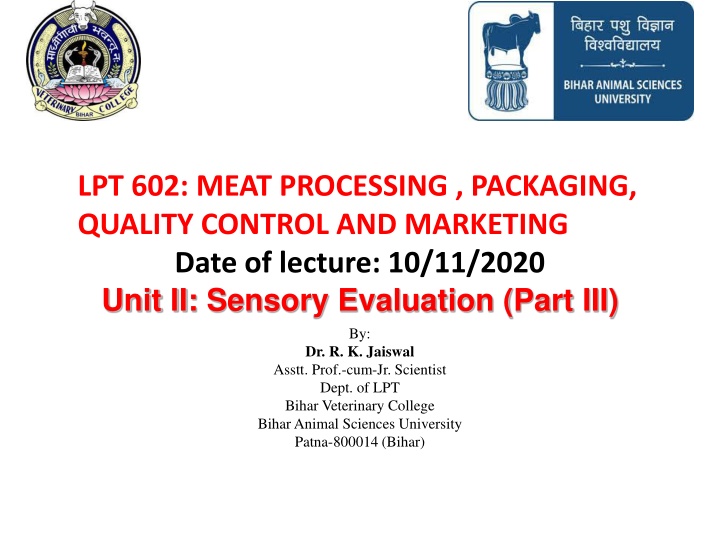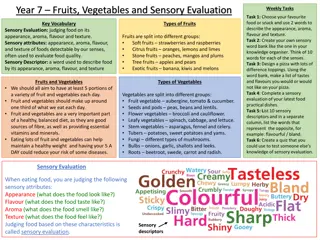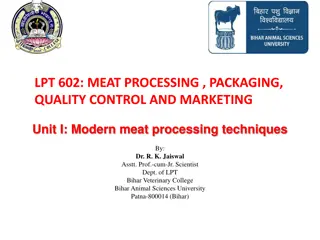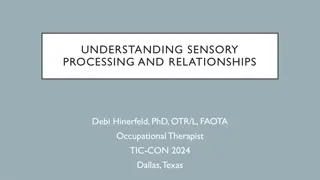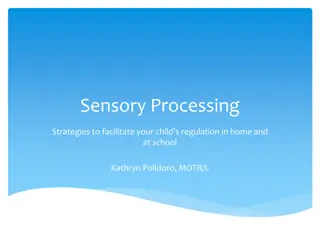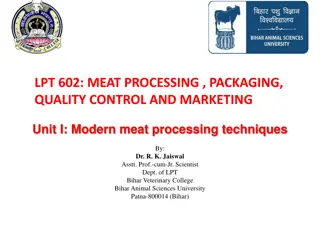Sensory Evaluation in Meat Processing: Panelist Selection, Training, and Sample Preparation
The lecture covers the sensory evaluation process in meat processing, focusing on the selection and training of panelists based on criteria like willingness, capability, and general health. Panelists are categorized as trained or semi-trained, with detailed guidelines for preparing and presenting meat samples for evaluation in a controlled laboratory setting. Specific requirements for the testing environment and sample preparation are discussed in detail, emphasizing the importance of standardizing the sensory evaluation process for accurate results.
Download Presentation

Please find below an Image/Link to download the presentation.
The content on the website is provided AS IS for your information and personal use only. It may not be sold, licensed, or shared on other websites without obtaining consent from the author.If you encounter any issues during the download, it is possible that the publisher has removed the file from their server.
You are allowed to download the files provided on this website for personal or commercial use, subject to the condition that they are used lawfully. All files are the property of their respective owners.
The content on the website is provided AS IS for your information and personal use only. It may not be sold, licensed, or shared on other websites without obtaining consent from the author.
E N D
Presentation Transcript
LPT 602: MEAT PROCESSING , PACKAGING, QUALITY CONTROL AND MARKETING Date of lecture: 10/11/2020 Unit II: Sensory Evaluation (Part III) By: Dr. R. K. Jaiswal Asstt. Prof.-cum-Jr. Scientist Dept. of LPT Bihar Veterinary College Bihar Animal Sciences University Patna-800014 (Bihar)
Selection & Training of Panelists Criteria for selection Willingness, availability, capability, sensitivity, selectivity, dependability and general health. Also fill up questionnaire indicating their food likes or dislikes and food allergies if any. For screening the sensitivity of the panelists Recognition test (qualitative determination) Threshold test (quantitative determination) Training of panelists accomplished by personal interviews, group discussion and improving their sensitivity further by serial dilution tests Training sessions continued till the sensory scores did not vary more than +1 from the mean scores (on 8-point hedonic scale).
On the basis of the training panelist are categorized 1. Trained panelists : To establish the intensity of sensory character or overall quality of meat and meat products Involved in all developmental and processing studies. 2.Semi-trained panelists : Normally familiar with the quality of different classes of meat In a semi-trained panel, individual variations are generally balanced by involving greater number of panelists
Preparation & Presentation Of Samples Testing environment 1. Sensory evaluation laboratory separate from the sample preparation room (only 45 cm x 30 cm connection allowed ) 2. Provision of air conditioning with exhaust to eliminate external odours. 3. Separate booth for each panelist having wash basin, water for oral rinsing, thermostatically controlled heating device, writing table, chair, water beakers and arrangements for colored as well as neutral white lights. 4. Also provision for white plastic serving trays, paper napkins, forks, knives and group discussion area equipped with a large table and stools to sit 12-15 persons. 5. Relative humidity 70 to 75% & temperature - 20 2 C for ideal laboratory conditions.
Preparation of sample Taken sample represents the total batch In case, meat has been presented in such a way that might make it unsafe microbiologically or chemically, then only the appearance and odour attributes may be evaluated Samples size : 1.32 to 2.5 diameter cubes or slices of 1.3 x 1.3 x 1.9 cm of hot meat ( AMSA 1978) As a thumb rule, the amount of sample - at least two bites in case of solids and 15 ml for liquids
Number & Presentation of Samples At least two pieces (cubes or slices) from steaks, roasts or nay other meat products should be presented to each panelist in a random order Samples should be assigned suitable codes preferably a 3 digit random numbers Ideally, two sessions per day or ten sessions per week. Generally 6 attributes and 6 samples are considered as absolute maximum for trained panelists because the sensory receptors become fatigued In paired difference test, maximum of 3 pairs & in consumer panel not more than two samples should be presented at a time
Reference/Control sample Reference sample can be designated as control sample against all other samples are to be compared It can be hidden control coded and served to the panelist with the experimental samples. The hidden control must be sufficiently similar to the sample being tested so that it is not immediately identified. It should be coded in the same way as experimental samples using a different code number each time it is presented to the panel. While conducting a storage study, control sample must be stored under same storage conditions for comparative study
Temperature of sample Time of conducting panel Panelists are more sensitive when slightly hungry. Ideal testing time - late morning/late afternoon or at least one and half hours after lunch Eating highly spiced food, smoking, taking drinks with lingering after-taste and sucking candies or chewing gum should be avoided before the test & 30 minutes gap may be allowed prior to conducting sensory evaluation. Expectation error can occur when panelists are given too much information about the nature of the experiment or the types of samples before tests are conducted.
